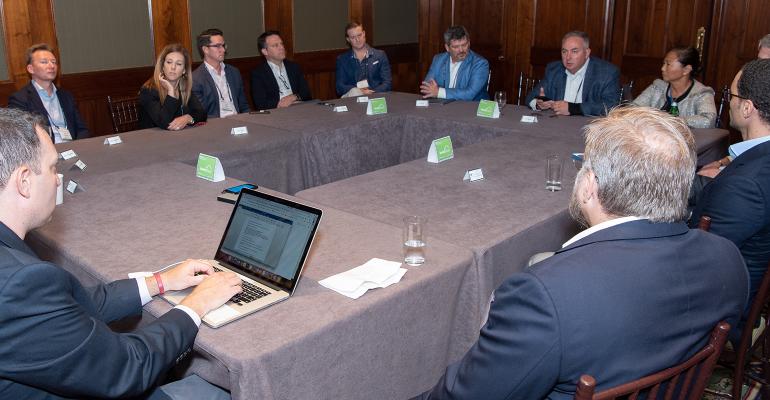Financial advisors need better tools to run better businesses. It’s really as simple as that … if only it were that simple. During a technology roundtable discussion at the Wealth Management Industry Awards last week, a group of technology providers and RIAs discussed how best to provide advisors with those tools.
From onboarding to cybersecurity to plain-old computer printouts, the needs of advisors—and their clients—vary from advisor to advisor. That makes it especially difficult for tech providers to create a one-size-fits-all tool for everyone.
“Ask any advisor; ask 10 advisors about technology, and you’ll get 11 opinions,” said Oleg Tishkevich, founder of Invent.us, a “cloud native” software development consulting company. “Every advisor has a very unique approach to how they do business.”
To combat that, instead of monolithic tech providers in the financial advisory space, there are many, generally, smaller ones that each service a niche aspect of an advisor’s business. Or, among those monoliths—think Envestnet—different types of additional technology are available via integrations for advisors to pick and choose the tools they need. The quality and depth of these integrations, most often using application programing interfaces (APIs), varies greatly and there is no standard for judging or comparing them.
“I think the integration is a real challenge with all the different components,” said Jodi Vleck, CEO of San Diego-based Beta Wealth Group. “I know everyone in our office is switching between emails, to the CRM, the financial planning, and it is very clunky,” she said.
In addition to being clunky, or the perception of clunkiness (some advisors are happy with the quality of their integrations), the question of ‘who are these systems being created for?’ is coming up increasingly. The advisor? The end client? And whom should they be created for?
To David Lau, CEO of DPL Financial Services, it’s really simple: “Technology platforms are built for advisory needs and what do advisors want and how can we help you do your job, and very little focus on the end consumer,” Lau said.
“In other industries, there's so much study into consumer behavior and how do consumers interact with this website and how do we get it more efficient? How do we drive efficiency and user experience? That doesn't really happen in financial services,” he said. “It's how can we focus on ourselves, do our job, and then we'll present the client what we want to present them, rather than, ‘let's talk to the clients. Let's get consumer feedback. Let's hear what they want.’”
To be sure, many tech companies do exactly that. Sean Lawlor, head of Enterprise Data Solutions at Envestnet, said a lot of A/B testing goes into the development of the company's products, but “you put 100 different people in a room, they’re going to want 100 different things.”
“It’s very difficult to get accurate and presentable information, and it’s super expensive to do this type of A/B testing for something like a client portal too,” he added.
Then there’s the history. Ten years ago there was a wave of consolidation driven by the major custodians, each of whom were building their own technology platforms to attract and retain advisors. Advisors, RIAs in particular being an independent-minded lot, did not want to put all their technology eggs into a single platform basket, and so in the last few years we have seen what is sometimes referred to as ‘the great unbundling.’ Rather than relying on that single custodial platform, RIAs are selecting best-of-breed applications with strong integrations to others to fill their core needs.
Consolidation is returning, however, but in different forms. Look at Fidelity’s acquisition of eMoney or Envestnet purchasing MoneyGuidePro. Then there are also business models mixed with technology that depart the traditional RIA form factor. For example, Personal Capital, with the mass market appeal of its free account aggregation tracking tools that its more traditional RIA side then uses the data from to find new clients. There are also big asset managers like BlackRock all crowding into the fintech space.
“For advisors, what it comes down to really is data,” said MyVest CEO Anton Honikman. “What you do with customer data and how to accurately aggregate it,” he said.
Jim Maher, CEO and founder of Archford Capital Strategies, said his RIA firm has created a type of “Dewey Decimal System,” similar to what a library uses to sort all the client data, which is a highly customized application built on top of Microsoft SharePoint. And the firm uploads the data themselves instead of asking the client to do it.
“We save them time, save them money and make them money,” he said. “Performance is performance, but if I’ve got all your information, you’re going to stay with me,” Maher said.
What it really comes down to is the creation of real collaboration technology, said Brian Edelman, CEO of managed security service provider FCI. This type of collaboration technology he has yet to see a working example of.
Those around the table offered variations on this theme, struggling to distill the essence until MyVest’s Honikman added his insight.
“The common theme, which I think is the most important technology you should be looking at in five to 10 years, is this customer data layer,” Honikman said. There is much talk about what technologies will peel and parse the data within it like machine learning or collaboration technologies, but is all going to be driven by this data layer.
“I think it’s hugely critical to this future of unlocking insights, whether it be for better collaboration, reporting, feedback, planning, whatever it is, even prospecting,” Honikman said.





